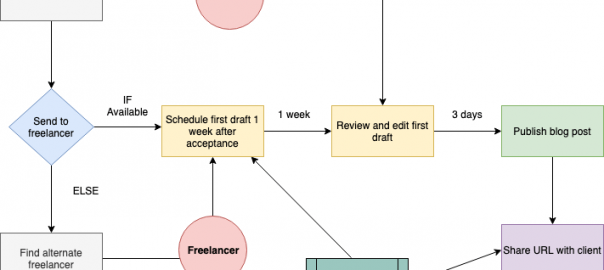— June 6, 2019
Project workflows bring order and structure to your agency’s operations. Learn how to create your own workflows in this guide.
When lay people think of creative work, they usually think of sparks of brilliance and inspirational “Eureka!” moments.
The truth is that creative work requires a lot of structure, especially if you want to stabilize and scale it.
This “structure” of creative work – or any other work – is defined by project workflows.
Project workflows help you map the steps necessary to take an item from start to finish. The meaning is in the term itself – workflow: the movement of data and activity.
Understanding and developing clear project workflows is crucial if you want to become better at running your agency. Complement your creativity and industry expertise with workflows and you’ll be able to deliver top-notch solutions consistently.
This guide will help you understand project workflows. You’ll learn why they’re important, what categories they fall into, and how to develop your own workflows.
What is a Project Workflow?
A workflow can be defined as “orchestrated and repeatable pattern of activity”.
A project workflow, thus, defines the sequence of activities, responsibilities, and data that must be exchanged or completed to move forward a project. Project workflows usually define a set of repeatable, well-structured activities, not one-off endeavors.
Think of it as an advanced version of a checklist. While a checklist is purely sequential, a workflow contains complex if-then logic to define the right sequence of events.
An easy way to understand workflows is to recall your last trip to the grocery store. “Buy two dozen eggs and a loaf of bread” is a checklist. But “If bread is less than $ 2, buy two loaves. Else buy only two dozen eggs” is an example of a workflow since it contains multiple logic-based steps.
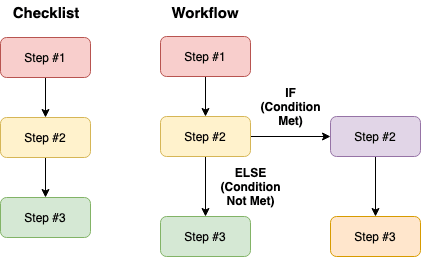
What is Not a Workflow
For a sequence to qualify as a workflow, there must be some interaction or dependencies between the steps.
If Step #2 has no correlation to Step #1, you can’t really call it a workflow. At best, you can call it a checklist.
The following, for instance, is a workflow:
- Create blog post
- Share blog post URL on Twitter
In this case, you can’t share the blog post URL until you actually create the blog post. Thus, Step #2 has a direct dependency on Step #1.
The following, however, can’t be classified as a workflow:
- Create blog post
- Share URL of last week’s featured post on Twitter
Why? Because Step #2 has no interaction with Step #1. You can share last week’s blog URL even before you’ve created the post for this week’s content.
Workflows vs Processes
Workflows are, by and large, task oriented. They define the activities that need to be performed and in what order.
A ‘process’, on the other hand, is a broader term and defines all the data, decision-making, reports, notifications, etc. that are necessary to take a task from start to finish.
For example, in a content marketing campaign, ‘Write draft’ > ‘Publish post’ > ‘Promote post’ is a workflow. It only defines what tasks must be completed to take a blog post from idea to live asset.
However, before you can write a draft, you also have to choose the right person to create it. And before that, you have to gather requirements and brainstorm a content strategy.
Once the post is published, you have to align your promotion with your PR and social media teams. Finally, post-publishing, you’ll have to send a report to your key stakeholders.
This list of events defines a “process”. Processes are deeper, more complex, and look at all the steps – tangible and intangible – necessary to produce a deliverable. Whereas workflows only consider the superficial sequence of steps from start to final delivery.
In other words, workflows are contained within processes, i.e. the former is a subset of the latter.
Why Workflows Matter
Project workflows change the way you approach project management. Instead of going about in a haphazard, ad-hoc fashion, they give you structure and order.
Let’s look at some of the specific, tangible benefits of adopting project workflows in your PM strategy:
1. Improve project management
A project workflow defines all the steps – including if-then logic – that go into creating a deliverable. They tell managers and employees exactly what needs to be done and in what order.
This brings much-needed structure to your project management. More importantly, they make it easier for new hires to get up to speed with your project execution approach. You don’t have to hold hands and show a new hire what to do next; the project workflow will guide them.
Furthermore, project workflows build predictability and scalability into your operations. Once you’ve mapped out the workflow for a deliverable, every project can use it. If you want to grow beyond a boutique agency, you’ll need this consistency and scalability.
2. More accurate cost and time estimates
A common pitfall of running an agency is inaccurate cost and time estimates. Deliverables that take longer than expected to produce or need more than the estimated resources can easily derail your agency.
Since project workflows define every step in the production process, they help you estimate your resource and time requirements better.
For instance, the project workflow for a blog post shows that you need an editor, a writer, and a strategist. Based on your prior experience and industry standards, you can also estimate how long each resource would take to create their part of the deliverable.

The result is better estimating, which, as you know, is crucial for a healthy agency.
3. More efficient operations
Are you using the most efficient path to create your deliverables?
Unless you map out your path, you won’t really know the answer to this question.
This is where project workflows help immensely. Once you’ve mapped out your workflow, you can spot inefficiencies and alter your path to remove them.
For instance, you might find that two steps in the process can be carried out simultaneously, such as content ideation and creating content calendars. Or you might find that a single resource can carry out multiple steps instead of handing it over to another team member.
The processes you use to create your work isn’t necessarily the best one. By mapping and reviewing your workflows, you can often find faster and more streamlined ways of doing things.
That’s not all. Project workflows also help you identify risks. Once you’ve mapped your path, you might realize that you’re overdependent on an outside contractor for a key step in the process. Or that you’re relying too heavily on a poorly maintained third-party framework.
You can then take remedial steps to avoid these risk events.
How to Use Project Workflows in Your Agency
Project workflows bring structure to your operations, help you identify risks, and improve the accuracy of your estimates.
But how exactly do you use them? What step-by-step process should you follow to add them to your project management approach?
I’ll share some answers below.
Types of Project Workflows
Project workflows can be broadly divided into two categories:
1. Process workflows
These workflows define a set of tasks that are predictable and repetitive. That is, before an item starts the workflow, you know exactly what path it should take.
Creating a blog post based on a title and creative brief would be a ‘process workflow’. That’s because you already know what steps you would take to create the post based on your past experience.
2. Case workflows
In a case workflow, you know what you’re going to create, but the path to reach final delivery isn’t always clear. You need to gather resources, conduct research, and understand requirements further before you can map out the workflow.
Building an app that you’ve never developed before is an example of a case workflow. You know what the end product looks like, but you don’t know which frameworks you’ll use and what resources you’ll utilize.
Which is to say, a case workflow is evaluated on a “case by case” basis.
Case workflows are rare in agencies. Most of the times, you’ll know what path you’ll take to produce the deliverable. Nonetheless, you can still speed up the execution of case workflows by developing templates to plug into the workflow.
Developing Your Own Project Workflows
Now that you know the two major types of workflows, it’s time to use them in your projects.
Here’s a step-by-step process to help you get started:
1. Make a list of services and deliverables
Start by making a list of all the services you provide and the deliverables associated with them. Usually, you’ll need to create several sub-deliverables before you can deliver the final project.
For instance, before you can create a final landing page, you need to create a mockup. And before you can create a mockup, you need to gather requirements through a creative brief.
Your goal in this step is to understand everything that you create in the process of taking a project from start to finish.
For example, a content marketing project might have the following deliverables:
- Creative brief
- Content marketing strategy document
- Content calendar
- Content style guide
- Blog post templates
- Blog posts
- eBooks
Some of these might be internal (i.e. meant for your own teams) while some will be external (i.e. meant for clients). A style guide, for instance, would be consumed internally, while a finished blog post would be shared with clients.
There will be dependencies between deliverables (a blog post, for instance, needs a creative brief), but we’ll get to that in the next step.
Make sure to follow the work breakdown structure guidelines and list only deliverables and not the activities associated with them. An easy way to understand the difference is to think in terms of nouns and verbs. If the item can be described via a noun, it is a deliverable. Else, it’s an activity.
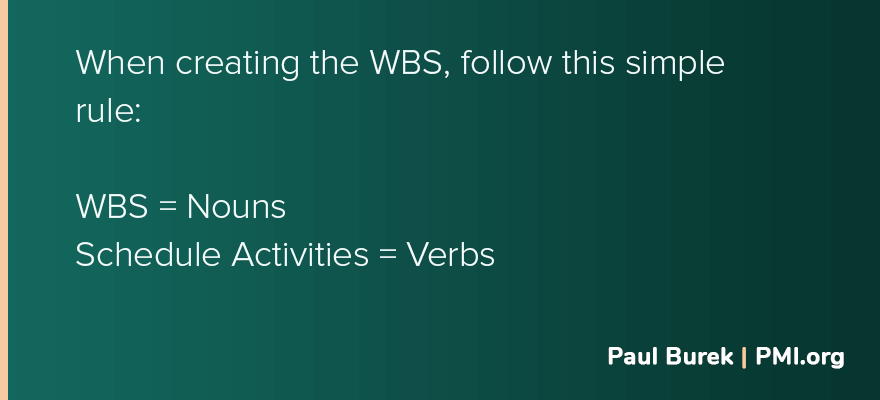
“Blog post template”, thus, is a deliverable. While “gather requirements for blog post template” is an activity.
Do this for all the services you provide. An additional benefit of this exercise is that it helps you understand your own agency’s operations better.
2. Map the Processes Used to Create Each Deliverable
For each of the deliverables you identified above, map the path you usually take to move the item from start to finish.
For instance, to create a blog post, you might take the following steps:
- Gather requirements from the client in the form of a creative brief
- Use takeaways from creative brief to create a style guide
- Create a content strategy based on creative brief and project requirements
- Brainstorm blog post topics and create a content calendar based on content strategy
- Create and approve an outline for each blog post
- Send approved outline to freelance writer
- Approve the first draft and send it to CMS (Content Management System)
- Edit draft in CMS and schedule for publishing
- Share finished URL with client
You’ll find that the dependencies for each deliverable are either:
- Deliverable-specific, i.e. completing the deliverable requires completing a prior step in the process. For example, before you can create a blog post, you need to create an outline. This outline will be unique to each blog post (the deliverable in question).
- Project-specific, i.e. the deliverable depends on an item that is universal to all deliverables in the project. For example, you need a creative brief before you can create any content – blog posts, eBooks, etc.
In the above example, you can map the entire process visually as follows. Note that the project-specific dependencies are highlighted separately. You need to only create them once and they can be used for all deliverables in the project.
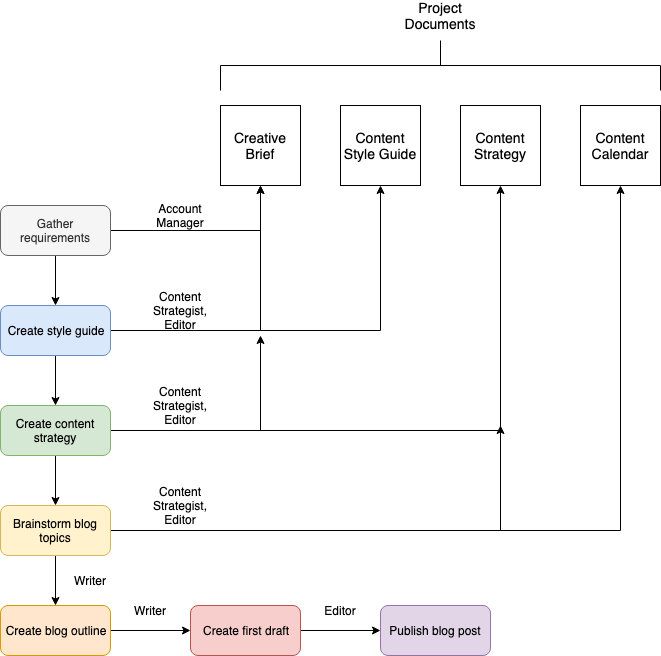
3. Create Project Workflows
The above exercise should give you a good handle on the path you need to follow to create an item. Think of it as a “proto project workflow”.
The next step is to map out all the resources, time, and paths the deliverable might take to go from start to finish.
What happens if the editor doesn’t sign-off on an outline? Or if the client does not approve the final post? Or if a freelancer drops out at the last moment and you have to find a replacement?
All these “if-then” scenarios are a part of the project workflow.
The best way to map out your workflows is to do it visually. Use software such as Microsoft Visio and Draw.io to draw out all these scenarios. Also, make sure to identify the resources you’ll need at each step in the workflow.
For instance, “creating a blog post” might have the following workflow:
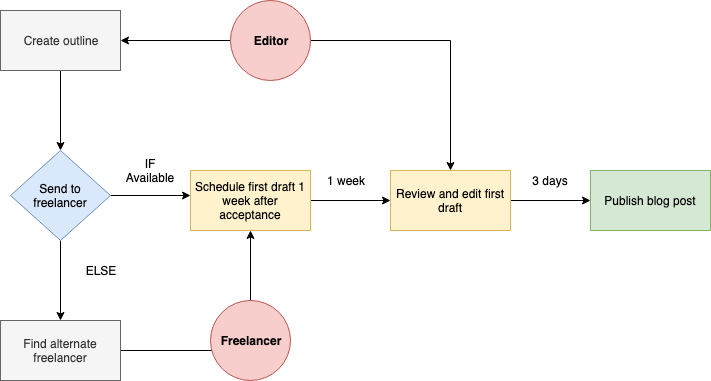
As the above diagram shows, if a freelancer drops out, you have an alternative in the form of an in-house writer. If an editor doesn’t approve an outline, the writer waits two days and goes ahead with the draft anyway.
Not only does this help you map out what resources you’ll need, but it’s also a fantastic way to manage risk. A beginner to your agency can use this workflow and know exactly what steps need to be completed and in what order to create a deliverable.
4. Optimize Workflows
The final step in the project workflow creation process is to optimize everything for better efficiency.
Look closely at the workflow you charted above. Is this truly the best path to create the deliverable? Are there steps you can remove? Resources that can be clubbed for better results? Tasks that can be completed simultaneously?
In particular, look for steps that can be automated. In the above example, you can set up an automated system to share the URL of the published post with your marketing team or client. Or you can bounce an unopened request email back to your inbox after 3 days of no response.
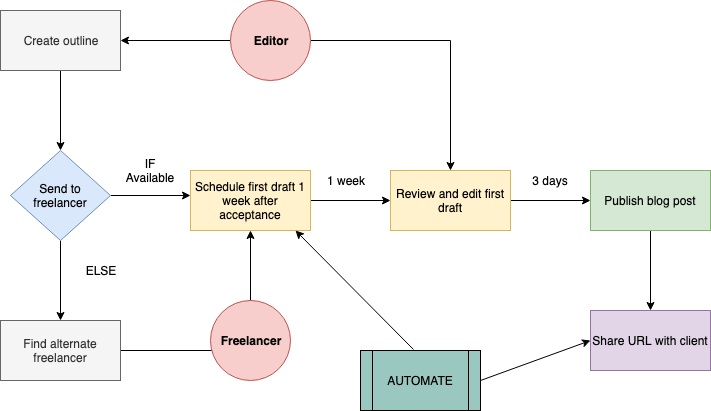
While you’re doing this optimization exercise, also think of how you can facilitate collaboration between and across teams. Is there a workflow that makes collaboration easier? If yes, make sure to prioritize it.
In the above example, getting content strategists and writers to collaborate on the blog post outline upfront can avoid much of the back-and-forth that happens when only writers create the outline.
Thus, a workflow that places strategist-writer collaboration before the outline creation might result in better work.
Optimization can be a tricky exercise. You have to be careful not to overdo it. Club too many steps together and you might find that your resources are exhausted. Ask the same resource to complete multiple steps simultaneously and you might end up paying the penalty for task switching.
Keep revisiting your workflows over time. Always ask: what can you do to improve efficiency? What steps can you eliminate or automate?
The more optimized your project workflows, the more efficient your agency.
While project workflows are necessary for better agency operations, you also need a robust agency management system. Try out a proven system such as Workamajig to transform how you run your agency. Workamajig’s scalable, consistent approach to management can drastically improve your productivity and lead to better results – creatively and financially.
Business & Finance Articles on Business 2 Community
(87)
